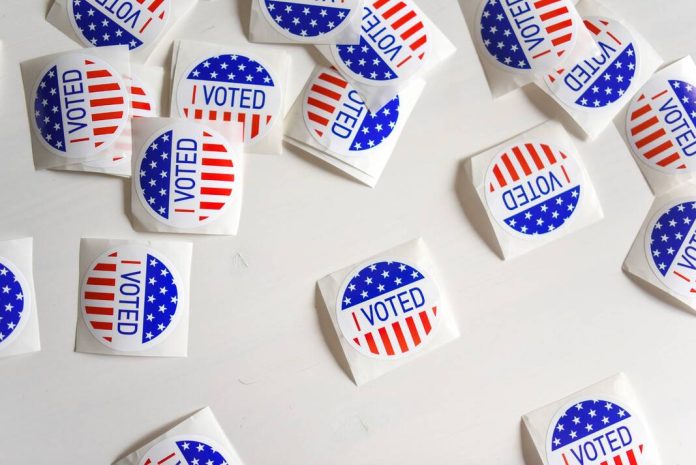About 1,800 Republicans will descend on Indianapolis next week and choose two of their party’s candidates to appear on the ballot this November. It’s a “throwback” primary system that instills power in the state parties and revs up competition at their state conventions.
At their respective state conventions this summer, Republican and Democratic delegates will determine the running mates for their party’s gubernatorial contender by choosing the candidates for lieutenant governor and the attorney general.
Indiana has a strong state party system, said Chad Kinsella, director of the Bowen Center for Public Affairs at Ball State University. The state convention has more weight than just being a party “pep rally,” he said, and Indiana is unusual in that these conventions hold a large role in deciding candidates.
On June 15, Republican delegates will choose between either Rep. Julie McGuire of Indianapolis, who is Republican gubernatorial candidate Mike Braun’s preferred running mate, or minister Micah Beckwith, who has campaigned for the office since last year. Currently, both candidates are touring the state to meet with delegates.
GOP Executive Director Joe Elsener said it’s pretty uncommon for a competitive lieutenant governor race, but it’s normal for the others.
Attorney General Todd Rokita is also running unopposed on the Republican side to retain his office.
The filing deadline for Democratic candidates is July 1. The faceoff for attorney general is expected to be between Destiny Wells and Beth White. Gubernatorial candidate Jennifer McCormick has not yet announced a preferred running mate for lieutenant governor, and no other candidates have publicized their entry in the race. The Democratic state convention is July 13.
So, who are the delegates?
Delegates tend to be people already involved in the party and often are former or current county and city officials. In the case of both parties, delegates tend to be more left or right than the candidates, who need to appeal to a larger voter base, Kinsella said. They’re basically the “cheerleaders” of the party, he said.
“It’s like, ‘here’s why we’re Democrats,’ ‘here’s why we’re Republicans,’” Kinsella said. “They’re really into the party, and they are true believers. They’re going to be a little bit more partisan than the average voter.”
It depends on the year, Elsener said, but the party has a diversity of opinions from its 92 counites, so they usually land with a 70/30 agreement.
This year’s delegates were elected in May’s primary, and party rules determine how many are needed to be elected. This year, Republicans will have 1,814 delegates. For the GOP, counties receive one delegate for every 550 votes cast for the party’s secretary of state candidate in that office’s last election.
They also choose the candidates for state auditor, state treasurer and secretary of state as well as determine the party’s platform in midterm years.
Though the job largely involves duties just once every two years, Elsener said some passionate candidates do launch small-scale campaigns with lawn signs, social media pushes, text messages and door-knocking. Candidate turnout has been good in recent years, he said, and county chairs haven’t had to make many appointments for empty delegate seats.
Some people run because they like a certain candidate or want to contribute to their party’s future, Elsener said. Others serve as delegates for decades, and if they aren’t elected, they’ll ask the chair to appoint them, he said.
“It’s just the love of the party. It’s the love of the process,” he said. “When all the delegates come together, we will have about 1,800. It’s fellowship. It’s community. It’s coming together to work for a common purpose.”
Nearly every state has its quirks when it comes to this process. Every state is unique, Elsener said, and Indiana is no different. Besides even using the delegate system, Indiana also differs in that delegates are elected rather than appointed, Kinsella said.
“The Indiana conventions, unlike a lot of state conventions, actually hold a lot of power,” Kinsella said. “A lot of those state conventions are kind of throwbacks.”
When it comes to who’s elected in these low-profile elections, name recognition from prior elections goes a long way, Kinsella said. Elsener added that last names higher in the alphabet tend to win more often than those farther down, and if a husband and wife run against each other, the wife typically wins more votes.
Kinsella said this system was more popular decades ago when the idea was these party faithfuls might be better candidate selectors than the larger party voters.
This system also enables those who are most involved in their parties, either through working on campaigns, raising money or contributing their own public service, to be rewarded with the opportunity to choose their party’s candidates, Elsener said.
“If you lived here your entire life, it’s one of those things that’s just like this is just how we do it,” Kinsella said. “It’s really unique, and it’s pretty neat There’s still power in the state parties in Indiana.”
By Cate Charron, Indianapolis Business Journal





